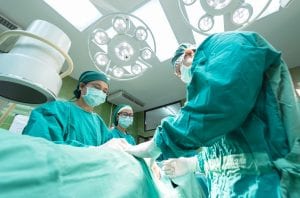“I’ve always defined that we’ll be successful when we help that first patient, when that patient walks into our headquarters and says, “This device made a difference for me.””
An interview with Robert Hamilton, PhD
Co-Founder & Chief Science Officer, Neural Analytics
By: Michelle Johnson, November 2, 2018
What did you want to be when you grew up?
I wanted to be an architect. Being an avid sports fan, my dream was to build baseball stadiums and other public event spaces. Throughout high school and early college, I slowly transitioned to civil engineering, accepting my relative lack of artistic ability required to be an architect. It wasn’t until college that through an injury to my elbow while playing collegiate baseball that I became interested in biomedical engineering and transitioned from wanting to build bridges and buildings to wanting to build things for human body.
What is that aim of your work with your company?
 To redefine how physicians and other healthcare professionals manage their patients by giving them access to critical information about blood flow to the brain. The fields of stroke, traumatic brain injury, dementia, and other neurological and cardiovascular conditions can benefit from this information, and by combining known ultrasound modalities with advances in artificial intelligence and medical robotics, we hope to provide this information where it is needed most. As an example, surgeons today in the operating room do not have visibility to blood flow in real time. With our technologies (Lucid M1 Transcranial Doppler and The Lucid Robotic System), we can provide potentially lifesaving information about blood flow and clots during surgeries.
To redefine how physicians and other healthcare professionals manage their patients by giving them access to critical information about blood flow to the brain. The fields of stroke, traumatic brain injury, dementia, and other neurological and cardiovascular conditions can benefit from this information, and by combining known ultrasound modalities with advances in artificial intelligence and medical robotics, we hope to provide this information where it is needed most. As an example, surgeons today in the operating room do not have visibility to blood flow in real time. With our technologies (Lucid M1 Transcranial Doppler and The Lucid Robotic System), we can provide potentially lifesaving information about blood flow and clots during surgeries.
What has it been like working in the industry side of science versus academia?
Looking back on it, the main reason we decided to start the company was to take our early clinical work – and the work of others within the field – from the academic bench and get it into the hands of clinicians and patients who need it. It was towards the end of my academic career when my co-founders (Leo Petrossian and Dan Hanchey) and I thought that the technology had enough traction to start the commercialization process. We still hold on to our academic roots today. Our research group performs clinical studies, publishes papers, presents at conferences, and applies for grants to develop new applications for our core technology. As part of our continued research and commercial efforts we continue to work closely with our academic partners—that’s why I’m here at Penn working with Dr. Ramon Diaz-Arrastia on traumatic brain injury. I think that the partnerships between academics and industry should be strong, and they should have their divisions as well, but they play a highly valuable role in translating basic research to devices and technologies that lead to improvements in patient outcomes.
What ultimately drives you in your work?
I’ve always defined that we’ll be successful when we help that first patient, when that patient walks into our headquarters and says, “This device made a difference for me.” Once we reach that milestone, there will be more, but our team remains focused on providing this technology to physicians to help them in their care of patients. We recently launched our devices and have had excellent feedback, with one surgeon mentioning that specific operations should not be performed without our device present. Knowing that we’re having that impact on an individual surgeon means a lot to the team and further drives us to continue our work.
What’s the best piece of advice you’ve ever gotten?
I was once told that you should never throw away results as you never know what those results might hold when looked at with a fresh eye. The core technology actually came from a mistake I made during my PhD work— that mistake led to early positive results that became the seed of our company’s innovation efforts. In clinical research and technology development, there is often this focus and reliance on statistical significance; however, it is important to remember that sometimes the most interesting results are not what you initially expected.
To learn more about Dr. Robert Hamilton and his company, click here.
To go back to the “Interviews with Scientists” page, click here.
